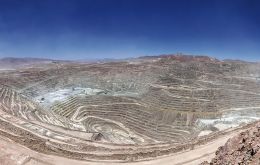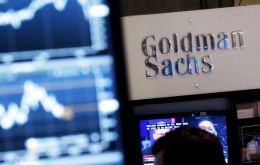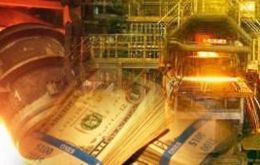MercoPress. South Atlantic News Agency
Tag: copper price
-
Thursday, June 18th 2020 - 13:30 UTC
Chile heading for its worst economic contraction in 35 years, central bank

The Chilean central bank said on Wednesday that the economy of the world’s top copper producer would contract between 5.5% and 7.5% in 2020, taking it to the lowest levels since the Latin American debt crisis of the 1980s.
-
Friday, July 19th 2019 - 09:47 UTC
Chile reduces copper price projection for 2019 as China's demand slows down

Chile, the world's largest producer of copper, reduced on Thursday its price projection for the precious metal for 2019 from US$3.05 to US$2.89 per pound due to a drop in demand from the planet's largest consumer, China.
-
Saturday, July 22nd 2017 - 22:58 UTC
Mining companies considering expansion in Chile as copper price recovers

Chilean authorities have approved a US$2.5 billion expansion of BHP Billiton's Spence copper mine, a local newspaper reported, though the company has not yet decided whether to go ahead with the project.
-
Tuesday, July 11th 2017 - 08:21 UTC
Chile lowers growth forecast in 2017; June data showed surprise deflation of 0.4%

Chile's government has cut its forecast for 2017 economic growth to 1.5% from 2.25%, Finance Minister Rodrigo Valdes said on Monday as the long-awaited recovery remains elusive.
-
Tuesday, January 12th 2016 - 01:40 UTC
As copper prices slide, the US dollar in Chile climbs to its highest value since 2003

The US dollar reaffirmed its value in the Chilean money exchange market during the first week of the year, trading in the commercial sector at an average of 728 Pesos, almost at its highest level of 735 twelve years ago, 31 March 2003.
-
Friday, November 20th 2015 - 07:47 UTC
Goldman Sachs forecasts another miserable year for commodities in 2016

A slowdown in China, which gobbled up raw materials everywhere from Australia to Chile, exacerbated a supply glut in most major commodities. And Goldman Sachs thinks the pressure is likely to persist as it noted its underweight position in commodities for the next 12 months.
-
Saturday, August 8th 2015 - 09:31 UTC
Chile's inflation climbs 0.4% in July to an annualized 4.6%; Peso slides 11%

Chile’s inflation rate rose to the highest this year in July as the Peso approaches its weakest level in more than a decade. Prices climbed 0.4% in the month, the National Statistics Institute said on its website Friday. Annual inflation accelerated to 4.6% from 4.4% the month before, while the central bank target is between 2% and 4%.
-
Friday, July 31st 2015 - 05:33 UTC
Dollar in Chilean Pesos climbs to its highest level since December 2008

The US dollar ended Thursday trading in the Chilean money exchange market at its highest since December 2008, that is 674 Pesos for the greenback. Currently and seven years ago the main reason has been the US monetary policy: the sub-prime crash in the US and fears of the debacle expanding to the rest of the world, and now growing chances of the Federal Reserve deciding on a rise of the prime rate.
